If you’re looking to increase shoulder and upper back strength, look no further than the upright row.
The upright row is an exercise that targets the posterior chain muscles, including the shoulders and upper back. It’s a pull exercise that involves pulling the weight towards you and working the muscles on the back side of your body.
However, it’s important to perform this movement with proper form to avoid injury and maximize results.
In this step-by-step guide, you’ll learn everything you need to know about mastering the upright row.
- What is an upright row?
- Muscle worked during it
- How To Do It
- Benefits of doing this
- Best upright row variations
- The correct and safe way to do upright rows
- Correct grip position
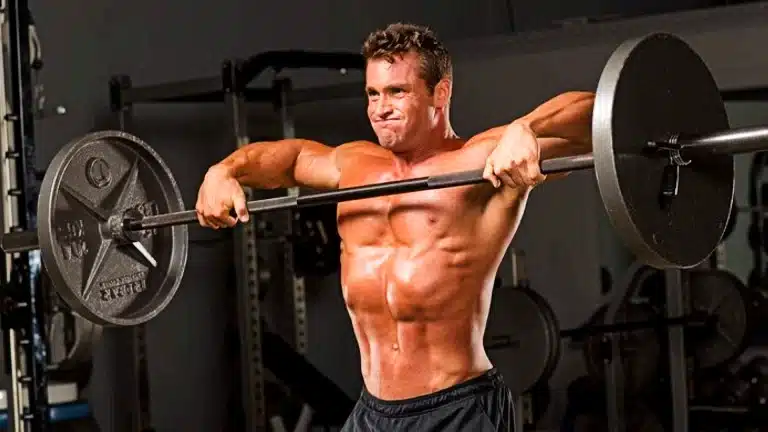
- What is An Upright Row?
- Muscle Worked During Upright Row Exercise
- How to Perform the Upright Row
- Starting Position
- Initiating the Movement
- Peak Position
- Returning to Start
- Benefits of An Upright Row
- 1. Build Shoulder And Upper Back Strength
- 2. Shoulder Stability
- 3. Increase Muscle Mass
- 4. Improved Performance
- 5. Improve Posture and Shoulder Stability
- The Correct and Safe Way To Do Upright Rows
- 1. Make sure your hands aren’t too close together
- 2. Avoid lifting too much weight
- 3. Don’t Pull the bar too high
- 4. Brace your core and keep your torso upright
- 5. Don’t roll shoulder forward
- Upright Row Grip Position
- Variations of Shoulder Upright Row
- 1. Wide Grip Barbell Upright Row
- 2. Dumbbell Upright Row
- 3. Cable Upright Row
- 4. One-Arm Dumbbell Upright Row
- 5. Smith Machine Upright Row
- 6. Kettlebell Upright Row
- 7. Resistance Band Upright Row
- 8. Prone incline wide-grip upright row
- Frequently Asked Question
- Is the Upright Row Bad for You?
- Are upright rows bad for your elbow?
- is upright row push or pull
- Which muscles do upright rows work?
- Can the upright row cause shoulder impingement?
- Are upright rows good for posture?
- Are upright rows better with dumbbells or barbell?
- How much weight should I use for an upright row?
- Are upright rows better than lateral raises?
- Takeaway
- Know More About Upright Workouts
What is An Upright Row?
The upright row is a compound weightlifting exercise that targets the muscles of the shoulder and upper back, including the deltoids, trapezius, as well as the rhomboids, and even the biceps — making it a great addition to any full-body workout.
It is performed by standing with a shoulder-width stance and holding a barbell, dumbbells, or a resistance band with an overhand grip.
The weight is then lifted along the front of the body to just below the chin, with the elbows pointing outward.
The exercise is named “upright row” because the weight is lifted up in a vertical, or upright, direction.
It is a common exercise in strength training programs and is often used to build upper body strength and muscle mass.
Muscle Worked During Upright Row Exercise
Upright rows are a movement that uses many joints and muscles at the same time.
A real upper body powerhouse, the upright row targets some of the body’s most integral muscle groups, including:
The Primary Muscles Worked during the upright row are Lateral deltoid, Rear Deltoid and Upper Trap.
Secondary Muscles Worked during upright row are: Anterior Deltoid, Supraspinatus, Brachialis, Brachioradialis, Biceps Brachii, Middle and Lower Trapezius, Rhomboids, Serratus Anterior and Teres Minor
A handful of other muscles worked or play the role of stabilizer muscles during upright row include your,
- Wrist flexors,
- Obliques, and
- Rectus abdominis.
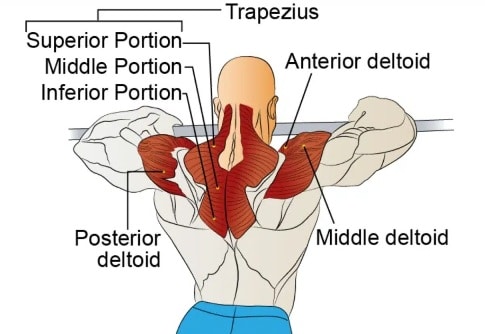
How to Perform the Upright Row
Performing the upright row correctly is crucial to reap its benefits while minimizing the risk of injury. Here’s a comprehensive step-by-step guide to ensure you execute this exercise with proper form:
Starting Position
- Stand with your feet shoulder-width apart to maintain a stable base.
- Hold a barbell with an overhand grip (palms facing you).
- Your hands should be slightly narrower than shoulder-width apart. Alternatively, you can use dumbbells or a cable machine for this exercise.
- Keep your back straight, shoulders relaxed, and chest lifted.
- The barbell should hang directly in front of you, with your arms extended and hands close together.
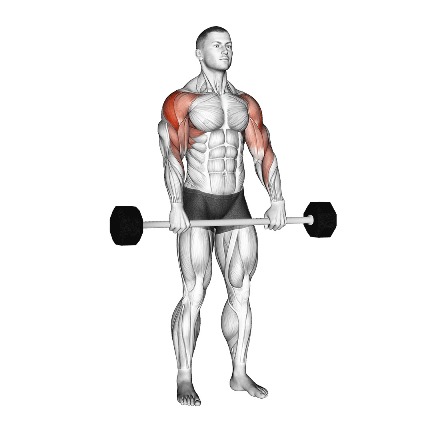
Initiating the Movement
- Take a deep breath to get ready for the lift.
- Start by bending your elbows and lifting the barbell up straight.
- Imagine you are trying to pull the bar up by leading with your elbows. Keep the bar close to you as you move.
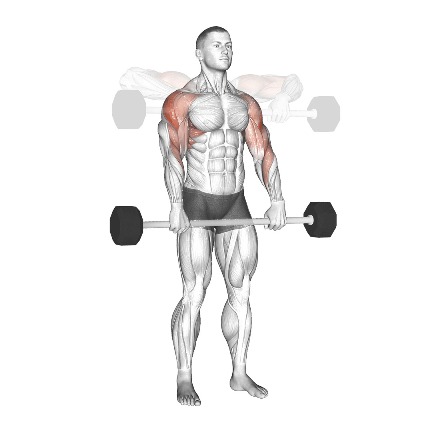
Peak Position
- As you lift, ensure your elbows are always higher than your wrists. This is crucial for targeting the shoulder and trap muscles effectively.
- The bar should come up to just below your chin or until your elbows reach shoulder height.
- It’s essential not to force the range of motion; go as high as comfortably possible.
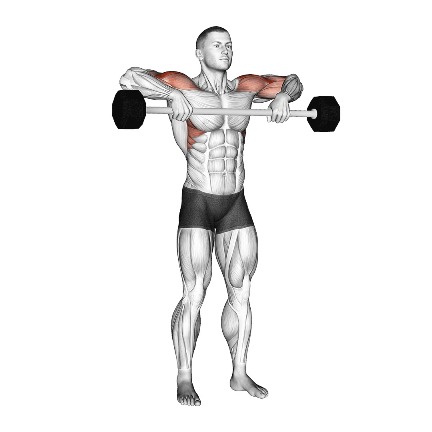
Returning to Start
- Slowly lower the barbell back down to the starting position in a controlled manner. This eccentric part of the movement is just as crucial as the lifting phase.
- Exhale as you lower the weight.
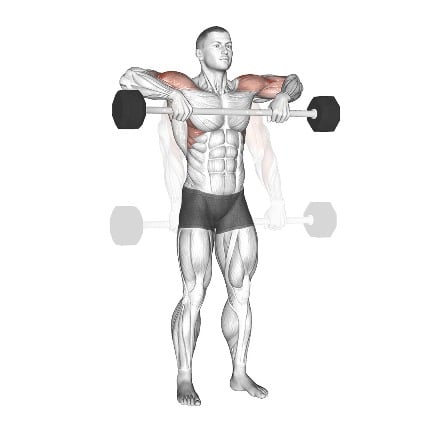
Benefits of An Upright Row
Here are the benefits of an upright row :
1. Build Shoulder And Upper Back Strength
Wide-grip upright rows are a great way to work and strengthen various upper body muscles, such as the serratus anterior, lateral deltoids, front delts, rear delts, rhomboids, and more.
Regularly doing this exercise can help strengthen these muscles, which can lead to better posture.
2. Shoulder Stability
Research shows that the upright row is one of the best exercises for building shoulder strength and stability.
The exercise targets the smaller, stabilizing muscles of the shoulder joint, which are essential for proper shoulder function and injury prevention.
The enhanced strength and stability gained from this exercise may result in enhanced performance in sports and other physical activities.
3. Increase Muscle Mass
It has been shown that upright rows can strengthen muscles in the shoulders, upper back (trapezius, rhomboids) and arms.
Due to its pulling motion, it targets a large group of major upper body muscles, which leads to increased muscle strength and hypertrophy.
4. Improved Performance
The use of wide-grip upright rows can help prepare your body for more advanced strength-training exercises, such as overhead presses, bench presses, and deadlift.
It helps to strengthen and condition the muscles involved in more complex weightlifting movements.
5. Improve Posture and Shoulder Stability
Upright rows can help improve posture by targeting the muscles responsible for maintaining proper alignment of the upper back and shoulders.
In addition, strengthening the upper back and shoulder muscles may contribute to improved shoulder stability.
The exercise can help prevent the negative effects of sitting for a long time and bad posture that are common in modern lifestyles.
The Correct and Safe Way To Do Upright Rows
We are going to teach you how to do an upright row correctly with form and techniques that best avoid shoulder pain and injury.
This allows you to take advantage of this great delt and upper trap isolation exercise.
1. Make sure your hands aren’t too close together
Placing your hands too close together can increase the amount of ulnar deviation (how much your wrist must bend to the side).
This can lead to injury at the wrist, and you can easily avoid it by moving your grip width to be a little wider so that it is more comfortable for you as you lift.
2. Avoid lifting too much weight
One of the most common mistakes people make when performing the upright row is using too much weight. This approach may place undue strain on your shoulders and increase your risk of injury.
To avoid this, start with a lighter weight and focus on maintaining proper form and technique.
Choose a barbell or weight that’ll allow a nice, slow and controlled movement.
3. Don’t Pull the bar too high
Pulling the bar too high can result in increased compression of the acromioclavicular joint, and thus can increase the likelihood of an impingement injury at the shoulder.
Controlling the movement and limiting your elbows to reach the same height as your shoulders ensure you are not exerting your shoulder and potentially causing an injury
4. Brace your core and keep your torso upright
As with any lift, maintaining a strong and stable core throughout the lift will aid with bracing and thus protect the spine.
When it comes to upright rows, this will also help to reduce or prevent swinging the weight away from your center of mass.
5. Don’t roll shoulder forward
When lowering the weight, make sure your chest is proud and shoulders pulled back/together (known as scapular retraction).
Retracting the scapulae puts the shoulders in a strong position to lift and will help focus the exercise on the deltoid.
Upright Row Grip Position
When performed correctly, the barbell upright row can be a fantastic muscle-building exercise for the upper back and shoulders, which can help to shape your upper arms and torso.
One key factor that can influence the muscle activation and emphasis in this exercise is the grip width.
There are three main variations of grip width: close grip, normal grip, and wide grip
- Close or narrow grip (half of shoulder width),
- A standard grip (shoulder width grip)
- A wide grip (wider than the shoulder)
All have their unique advantages and disadvantages. Let’s take a closer look at each of these variations:
- The normal grip upright row provides overall shoulder development and is suitable for those seeking balanced muscle activation.
- The narrow grip upright rows places emphasis more on the upper trap and a little lesser on the lateral delt and rear delt.
- The wide-grip upright row places heavy emphasis more in the lateral and rear deltoid and little lessor on the upper and middle trap
- Furthermore, the wider grip allows some cheating movement, thereby allowing you to lift more weight.
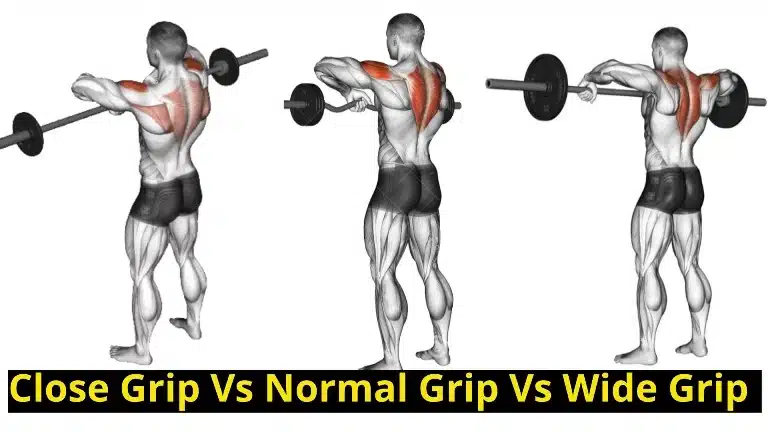
Variations of Shoulder Upright Row
There are several variations of the upright row that you can use to target different areas of the shoulders and add variety to your workout routine.
You can also perform the upright row with a cable machine or resistance bands, which can provide a different type of resistance.
Beginners are recommended to start with a cable machine, dumbbells, EZ bar, or bands.
Here are seven different ways to do an upright row using different equipment.
- Wide Grip Barbell Upright Row
- Dumbbell Upright Row
- Cable Upright Row
- One-Arm Dumbbell Upright Row
- Smith Machine Upright Row
- Kettlebell Upright Row
- Prone incline wide-grip upright row
1. Wide Grip Barbell Upright Row
The wide grip upright row is a variation of the traditional upright row exercise where the hands are positioned wider apart on the bar or dumbbells.
Barbell upright row is an excellent exercise to build huge Trapezius muscles and create that deltopectoral separation. Upright and shrugs, build massive traps.
This variation targets slightly different muscle groups and offers unique benefits compared to the standard grip.

How To Do Wide Grip Barbell Upright Row
- Hold a barbell with an overhand grip and stand with your feet hip-width apart.
- Your grip on the barbell should be wider than shoulder-width apart. Let it hang in front of you.
- While keeping your barbell close to your body, lift the bar and get it up to chest height using your arms.
- Allow your shoulder blades to move naturally with your shoulder joints. Pause at the top of the movement.
- Now, lower the bar under controlled motion until it comes back to its starting position.
- Repeat for your desired number of repetitions.
Tips and Form
- Focus on keeping your elbows higher than your forearms.
- Keep a controlled motion and avoid jerky movements.
- Keep your body upright, your shoulders back, and your chest out.
2. Dumbbell Upright Row
The dumbbell upright row is a compound exercise that builds stronger and bigger traps, and rear deltoids (Shoulder).
These exercises variations allow for a greater range of movement (ROM). Dumbbells require more balance than barbells or machines, which can lead to greater muscle fiber recruitment.
It is a simple exercise to perform. You hold a dumbbell in each hand and lift them vertically until they’re level with your collarbone, before lowering them back down.

How To Do Dumbbell Upright Row
- Stand with your feet shoulder-width apart, holding a dumbbell in each hand with an overhand grip (palms facing your body).
- Keep your arms fully extended, allowing the dumbbells to hang in front of your thighs.
- Engage your core, maintain a slight bend in your knees, and keep your back straight.
- Lift the dumbbells by raising them vertically towards your upper chest, leading with your elbows.
- As you lift, focus on squeezing your shoulder blades together and keeping the dumbbells close to your body.
- Once the dumbbells reach the top of the movement near your upper chest, pause briefly for a peak contraction.
- Slowly lower the dumbbells back to the starting position in a controlled manner.
Tips and Form
- Remember to exhale while you exert.
- Keep a controlled motion and avoid jerky movements.
- Keep your back straight, core engaged, and avoid leaning during the exercise.
3. Cable Upright Row
The cable upright row is a variation of the upright row and an exercise used to build the muscles of the shoulders and traps.
A cable pulley machine can be used for a shoulder upright row in that it provides constant tension on the target muscles as you move the weight through the range of motion.
Cable machines keep tension on the muscles throughout the entire range of motion, ultimately increasing muscle activation and hypertrophy.
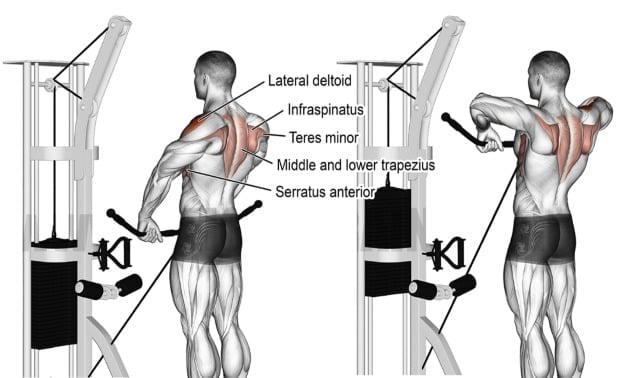
How To Do Upright Row With Cable
- Attach a straight bar to a low cable pulley.
- Grab the bar using a shoulder-width or wider overhand grip.
- Stand close to the pulley with your body upright, your shoulders pulled back.
- Exhale as you pull the bar up the front of your body until it reaches the level of your lower or middle chest.
- Do not pull the bar up any higher. Hold for a count of two.
- Inhale as you lower the bar to the starting position.
Tips and Form
- Bend slightly at the knees and stand with feet shoulder-width apart.
- Keep your shoulders back, chest out, and body upright.
4. One-Arm Dumbbell Upright Row
The single arm upright row is an upper body exercise that predominantly targets the anterior and lateral deltoids, which are responsible for adding width to your shoulders.
One arm dumbbell shoulder upright row is the unilateral variation on the dumbbell upright.
The single-arm dumbbell upright is a popular movement for building stronger and bigger traps and shoulders.

How To Do an Upright Row With One Arm
- Stand with your feet shoulder-width apart.
- Hold a dumbbell in your left hand at your side.
- Slowly shrug your left shoulder up toward your ear.
- At the top, pause for a moment and contract the muscles.
- Slowly lower the weight back to the starting position.
- After completing all reps on the left side, repeat on the right side.
- Repeat for the desired number of repetitions.
Tips and Form
- Keep a controlled motion and avoid jerky movements.
- Keep your back straight and core tight.
- Pause and squeeze the traps at the top of the movement, and then lower the dumbbells really slowly if you want to add a bit of intensity to the exercise.
5. Smith Machine Upright Row
The Smith machine upright row is a variation of the upright row that can help get you bigger deltoids and trapezius muscles.
Compared to using dumbbells or a barbell, the smith machine offers an advantage for performing upright rows with better balance and control.
The Smith Machine’s guided bar path helps ensure proper form and technique throughout each repetition of the exercise.
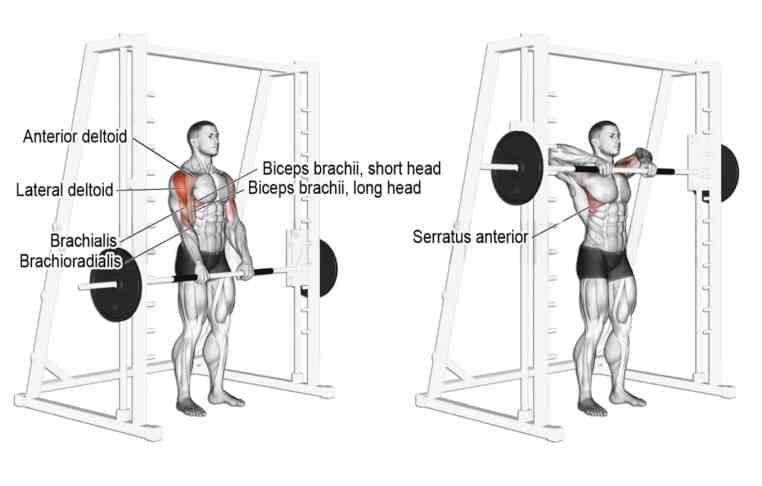
How To Do Upright Row With Smith Machine
- Select the desired weight and load it onto a barbell.
- Unpack the bar by rotating the safety latches off the j-hooks.
- Inhale, brace your abs, and then lead the movement by driving the elbows high as you pull the bar to chest height.
- When the bar has reached its peak, reverse the movement slowly while controlling the bar back to the starting position.
- Repeat for the desired number of repetitions.
Tips and Form
- Focus on keeping your elbows higher than your forearms.
- Avoid using momentum to lift the bar. Instead, focus on deriving power from the upper body.
6. Kettlebell Upright Row
The Kettlebell upright row is a variation of the dumbbell shoulder upright row, and It allows more movement in your wrists and arms and is less likely to force any internal rotation of your shoulder.
Again, opt for a kettlebell in a bit less than half the weight of a barbell you were working with.

How To Do Upright Row With Kettlebell
- Stand with your feet shoulder width apart and the kettlebell in both hands.
- Tighten your core and lift the kettlebell by raising your elbows to your shoulders. Keep your elbows above your wrists.
- Control the kettlebell on the way back down, making sure to lower the kettlebell all the way down, so your arms are fully straightened.
- Repeat for the desired number of repetitions.
Tips and Form
- Do not swing your upper body, try to keep your body steady and only move your arms.
- Keep a controlled motion and avoid jerky movements.
- Keep your back straight.
7. Resistance Band Upright Row
The resistance band upright row is a variation of the upright row and an exercise used to build the muscles of the shoulders and traps.
Utilizing the resistance band is useful in that it provides constant tension on the target muscle group as you move the weight through the range of motion.
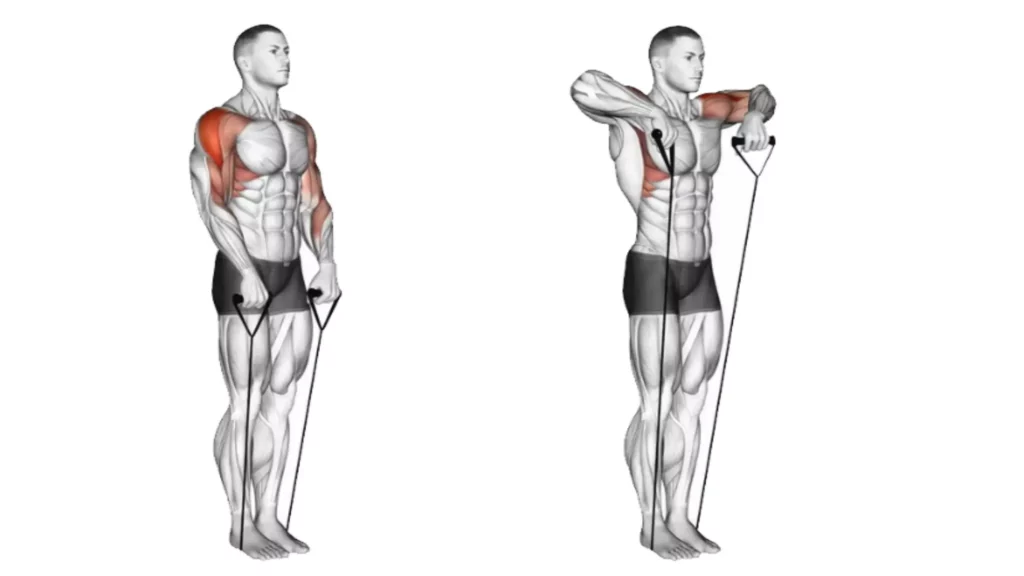
How To Do Resistance Band Upright Row
- Stand on a resistance band and hold the handles with palms facing inwards, resting on your thighs.
- Now, keep your back straight and lift the band up towards your chin, keeping your elbows higher than your forearms.
- Do not pull the band up any higher. Hold for a count of two.
- Inhale as you lower the band to the starting position.
- Repeat for the desired number of repetitions.
Tips and Form
- Bend slightly at the knees and stand with feet shoulder-width apart.
- Don’t allow your back to arch as you pull the band up.
- Keep your shoulders back, chest out, and body upright.
8. Prone incline wide-grip upright row
The prone incline wide-grip upright row is an exercise variation that targets the upper back, shoulders, and arms.
It involves performing an upright row motion while lying face down on an incline bench with a wide grip.
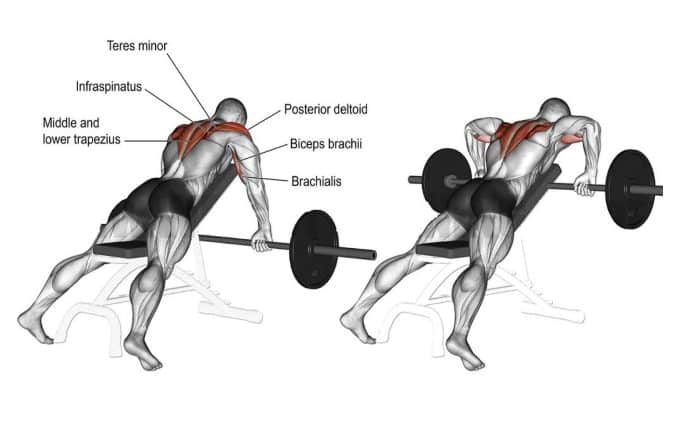
How To Do Prone incline wide-grip upright row
- Lie chest down on an incline bench set to about 45 degrees and rest your knees on the seat.
- Holding a loaded barbell with a shoulder-width, pronated (overhand) grip, and let your arms fully extend.
- Row the weight up until elbows are bent at 90 degrees and then slowly lower it back down.
- Repeat for the prescribed number of repetitions.
Tips and Form
- For shoulder safety, avoid using a narrow grip with all upright rowing exercises.
- Keep a controlled motion and avoid jerky movements.
Frequently Asked Question
Is the Upright Row Bad for You?
The upright row exercise is either good or bad, it mainly depends on how it’s performed.
In the classic version of the upright row, you start by standing with an EZ curl bar. Your hands are positioned relatively close together, potentially even at the center of the bar.
The movement involves pulling the bar upward towards your neck, while actively driving your elbows as high as possible.
When your elbows are higher than your shoulders, the bar pulls your shoulder joint into something called “internal rotation”. This is especially true if you’re going heavy on your upright rows.
Suddenly, the head of your humerus (or upper arm bone) starts closing the space between other bones in the area. And all the bones in your shoulder become prone to rubbing against rotator cuff tendons and soft tissue.
All of this can lead to injury over time.

You shouldn’t be scared out of integrating the shoulder upright row into your routine.
There are several ways you can look to improve your technique in order to perform the upright exercises in a safe and effective way.
Are upright rows bad for your elbow?
No, the upright row is not harmful to your shoulders, wrists, and elbows. It is important to make sure you are performing the upright row with proper technique, modifying the exercise based on your individual needs, and considering your training program as a whole.
is upright row push or pull
The upright row is primarily considered a pull exercise as it involves pulling the weight vertically towards the body.
A push exercise involves pushing a weight away from the body, such as a bench press or push-up, while a pull exercise involves pulling a weight towards the body, such as a row or pull-up.
Which muscles do upright rows work?
The upright row is a compound exercise that primarily works the muscles of the upper back, including the trapezius, rhomboids, and latissimus dorsi. It also works the muscles of the forearms and biceps to a lesser extent.
Can the upright row cause shoulder impingement?
Shoulder impingement can occur when performing the upright row with improper form or too much weight.
To avoid this, keep your elbows close to your body and your wrists straight throughout the movement.
Are upright rows good for posture?
Upright rows can be a good exercise for improving posture, as they work the muscles of the upper back, including the trapezius, rhomboids, and latissimus dorsi.
These muscles are responsible for moving, rotating, and stabilizing the shoulder blades, and strengthening them can help to improve posture.
However, it is important to maintain proper form when performing upright rows to ensure that they are effective and safe.
In addition to upright rows, there are other exercises that can help to improve posture, such as planks, bird dogs, and seated rows.
Are upright rows better with dumbbells or barbell?
Both dumbbells and barbells can be used to do upright rows.
The best choice for you may depend on your personal preference and the equipment you have available.
Here are some things to think about:
Dumbbell Upright Row:
- Greater range of motion
- Allows independent arm movement
- Requires greater core stabilization
- They may also be easier to grip.
- Offers various grip options for different muscle emphasis
Barbell Upright Row:
- Allow you to lift heavier weights
- Promotes symmetrical movement
- May provide better wrist alignment
- increase your strength and build muscle mass.
- Suitable for overall upper body development and coordination
I would suggest using dumbbells instead of a barbell if you have any pre-existing injuries or conditions. Dumbbell will allow for a more natural movement pattern and put less strain on your shoulders, as they will affect your shoulders.
Ultimately, the best choice for you will depend on your specific goals and needs. It may be helpful to try both and see which feels more comfortable and effective for you.
How much weight should I use for an upright row?
It depends on your goals and how strong you are. You should not do this exercise with a lot of weight and few repetitions because it is a risky exercise for your joints.
Pick a weight that allows you to do 10 to 20 reps and 3-4 sets.
If you don’t use enough weight, you won’t get the benefits of the exercise, but if you use too much weight, you’ll end up with bad form and the possibility of getting hurt.
Start with a weight that you can lift around 15 times with good intensity.
Are upright rows better than lateral raises?
It’s not really accurate to say that one exercise is “better” than the other, as both the upright row and lateral raise.
- The upright row is a compound exercise that targets the upper back and shoulder muscles, including the trapezius, rhomboids, and deltoids. It is a good exercise for building strength and mass in these muscles.
- The lateral raise is an isolation exercise that targets the lateral head of the deltoid muscle. They are good exercises for shaping and strengthening the shoulders, and can also help improve shoulder stability and mobility.
In general, it is a good idea to include a variety of exercises in your workout routine to ensure that you are targeting all the muscles in your body and avoiding overuse injuries.
You can try incorporating both upright rows and lateral raises into your routine to get the benefits of both exercises.
Takeaway
Upright row is an almost total upper body movement, targeting your shoulders, traps, forearms, and biceps. You can alter the movement by switching to dumbbells or by isolating your lateral delts further by utilizing lateral raises.
Try placing this exercise early on in your workout as it involves many muscles, and you will want to smash this one whilst you’re fresh.
Thanks for reading.
Know More About Upright Workouts
- Upright Barbell Row: How To Do, Muscle Worked & Benefits
- How To Do Single Arm Upright Row and Tips
- 20 Best lateral deltoid (Side Deltoid) Exercises & Workout
- Dumbbell Upright Row: Muscle Worked, Benefits
- Rope Upright Row: Muscle Worked, Benefits, Form
- How To Do Single Arm Upright Row and Tips
Reference
- Schoenfeld, Brad MSc, CSCS; Kolber, Morey J PT, PhD, CSCS; Haimes, Jonathan E BS, CSCS: The Upright Row: Implications for Preventing Subacromial Impingement. Strength and Conditioning Journal: October 2011 – Volume 33 – Issue 5 – p 25-28
- Ronai, Peter MS, CSCS, RCEP: Exercise Modifications and Strategies to Enhance Shoulder Function. Strength and Conditioning Journal: August 2005 – Volume 27 – Issue 4 – p 36-45
- McAllister M, Schilling B, Hammond K, Weiss L, Farney T. Effect of grip width on electromyographic activity during the upright row. J Strength Cond PMID: 22362088 DOI: 10.1519/JSC.0b013e31824f23ad
- Cools AM, Witvrouw EE, Declercq GA, Danneels LA, Cambier DC. Scapular muscle recruitment patterns: Trapezius muscle latency with and without impingement symptoms. Am J Sports Med 31: 542–549, 2003.
- Int J Environ Res Public Health. Trapezius muscle timing during selected shoulder rehabilitation exercises. 2021 Jun 14;18(12):6444. doi: 10.3390/ijerph18126444.PMID: 34198674
- Lorenzetti S, Dayer R, Pluss M, List R. Pulling exercises for strength training and rehabilitation: movements and loading conditions. J Funct Morphol Kinesiol. 2017;2(3):33. doi:10.3390/jfmk2030033
- Mazur LJ, Yetman RJ, Risser WL. Weight-training injuries. Common injuries and preventative methods. Sports Med 16: 57–63, 1993.

Manish brings over 10 years of hands-on experience in weight lifting and fat loss to fitness coaching. He specializes in gym-based training and has a lot of knowledge about exercise, lifting technique, biomechanics, and more.
Through “Fit Life Regime,” he generously shares the insights he’s gained over a decade in the field. His goal is to equip others with the knowledge to start their own fitness journey.
